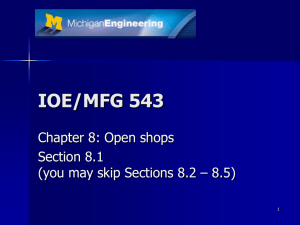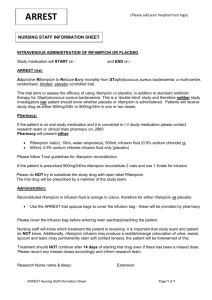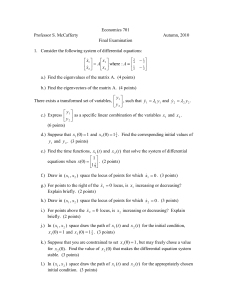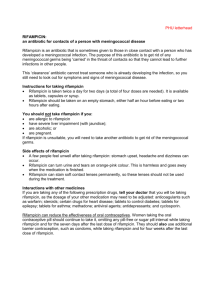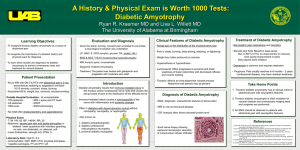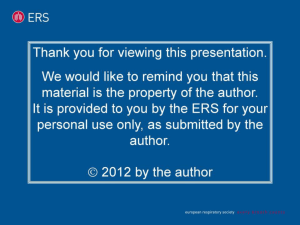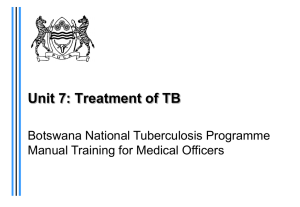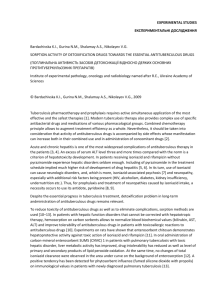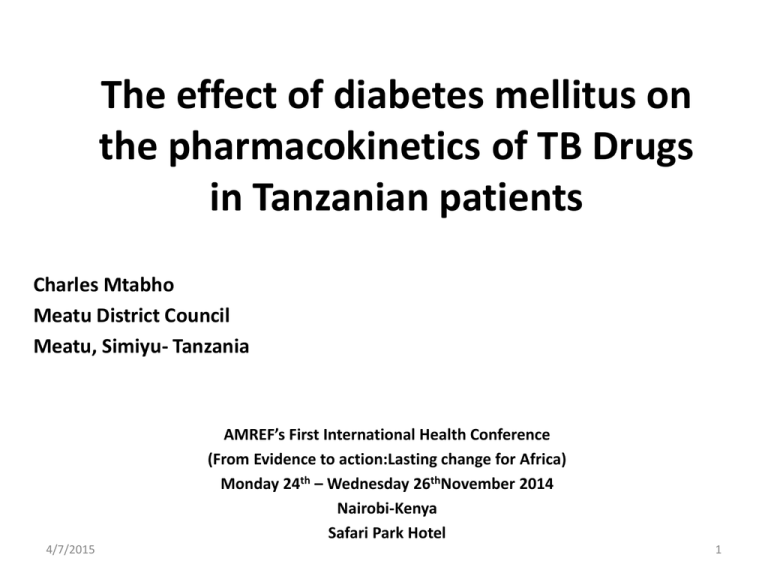
The effect of diabetes mellitus on
the pharmacokinetics of TB Drugs
in Tanzanian patients
Charles Mtabho
Meatu District Council
Meatu, Simiyu- Tanzania
AMREF’s First International Health Conference
(From Evidence to action:Lasting change for Africa)
Monday 24th – Wednesday 26thNovember 2014
Nairobi-Kenya
Safari Park Hotel
4/7/2015
1
Introduction
Diabetes mellitus is a well-known risk factor for TB
With the global increase in cases of type 2 DM, the
association between TB and DM is re-emerging
TB is more difficult to treat in diabetic patients
— less favourable response to TB treatment
4/7/2015
2
……introduction
DM patients have lower plasma concentrations of
certain drugs1,2
Absorption, distribution, metabolism and/or excretion of
drugs are changed
If this also applies to anti-TB drugs, this may at least
partly explain the slower response to TB treatment in
patients with DM
1.Gwilt et al. (1991). Clin Pharmacokinet
2.Dostalek et al. (2012) Clin Pharmacokinet
4/7/2015
3
……introduction
Indonesian study1- exposure to rifampicin was 53%
lower in patients with TB and DM, compared with
patients with TB only3
—this was attributed to DM and to the higher weight of
patients with DM
Indonesian study2- no differences in drug exposure4
Peruvian study- No difference in PK parameters5
3.Nijland et al. Clin Infect Dis 2006 4.Ruslami et al. AAC 2010 5.Requena-Mendez et al AAC 2012
4/7/2015
4
……introduction
These findings need more research
– Ethnic differences
– Study African TB patients because the African continent
has the highest TB incidence and mortality rates
• Tanzania in 2012, the incidence rate of TB was 169 per 100,000
population
• The diabetes prevalence in adults 20-79 is estimated at 7.8% in
2013.
4/7/2015
5
Methods
Study design -observational pharmacokinetic study
20 TB patients without DM and 20 TB patients with
DM were recruited at Mawenzi Hospital as well as
other hospitals around the region which treat TB
TB was diagnosed according to the Tanzanian
guideline and practice- clinical symptoms and signs,
chest x-ray examination, sputum smear microscopy
Diabetic patients were included if they had a
previously established diagnosis of DM and diagnosis
was confirmed at the time of PK sampling
4/7/2015
6
……methods
Patients with a body weight above 50 kg received 4
FDC tablets daily (300 mg INH, 600 mg RIF, 1600 mg
PZA and 900 mg ETH), those below 50 kg received 3
FDC tablets (225 mg INH, 450 mg RIF, 1200 mg PZA
and 675 mg ETH)
Diabetic patients were either on dietary
management alone, or oral hypoglycaemic agents
and/or injectable insulin.
4/7/2015
7
……methods
Sample collection
– PK sampling done after 2 weeks, given the
expected steady state of the drugs
– Patients fasted at least 8hrs before drug intake
and took a standardised breakfast within 30
minutes after drug intake
– Serial venous blood samples before, and at 1, 2, 3,
4, 6, 8, 10 and 24 hours after observed TB drug
intake
– Plasma was separated and kept frozen at -80oC
4/7/2015
8
……methods
Pharmacokinetic analysis
– Plasma concentrations of INH, acetylisoniazid, RIF,
desacetylrifampicin, PZA & ETH were assessed by validated
high-performance liquid chromatography (HPLC)
– Pharmacokinetic evaluations were performed using noncompartimental methods in WinNonLin
– PK parameters; Cmax , Tmax, AUC0-24h, T1/2, CL, Vz
4/7/2015
9
……methods
Statistical analysis
– Data was presented as mean (SD), median (IQR)
– Comparison of subgroups - two-sample t-test or Wilcoxon
rank-sum test
Univariate and Multivariate analyses to assess the
effects of age, sex, body weight, dose in mg/kg, HIV
status, acetylator status, fasting plasma glucose and
HbA1c on the AUC0-24h and Cmax of the four first-line
TB drugs
All statistical analyses were performed using SPSS
version 20 (SPSS Inc, Chicago II).
4/7/2015
10
Results
Parameter
TB-DM
TB
P-value
5[25%]
4[20%]
0.705**
Age (years; median[IQR])
49(40-56)
38(30-42)
0.001*
Body weight (kg; mean[SD])
58.7(12.3)
55.7(6.4)
0.346
BMI(kg/m2 mean[SD])
20.6(4.0)
19.5(2.4)
0.293
Rifampicin
Isoniazid
9.8(1.4)
10.4(0.9)
0.118
4.9(0.7)
5.2(0.5)
0.118
Pyrazinamide
25.5(3.8)
27.8(2.4)
0.029
18(2.5)
19.1(1.7)
0.118
15.9(13.1-18)
6.95(5.7-7.4)
7(35%)
7(35%)
-
106.4[22.7]
-
-
Sex (female, n[%])
TB drugs
Dose per kg (mg/kg, mean[SD])
Ethambutol
FBG(mmol/L, median(IQR))
HIV positive, n(%)
HBA1c(mmol/mol; mean[SD])
<0.001*
*Mann-Whitney U test
**chi square test
4/7/2015
11
Pharmacokinetic parameters of tuberculosis drugs in Tanzanian diabetic and
non-diabetic TB patients in northern Tanzania
Drug/PK parameter
p-value
TB-DM
TB
29.91[1.77]
39.91[1.26]
0.044
7.92[1.71]
8.92[1.28]
0.373
9[47.4]
7[35.0]
0.433
Rifampicin
AUC0-24, h*mg/L
Cmax, mg/L
Proportion with Cmax below reference range, n[%]c
Tmax, h[IQR]b
2.12[1.03-3.30]
1.08[0.98-2.05]
0.027
T1/2, h
1.44[1.30]
1.80 [1.38]
0.026
Vz, L
38.74[1.79]
37.30 [1.31]
0.794
CL, L/h
18.60[1.74]
14.40 [1.24]
0.063
Isoniazid
AUC0-24, h*mg/L
5.41[2.61]
10.61[1.94]
0.015
Cmax, mg/L
1.65[2.15]
2.77[1.45]
0.010
Proportion with Cmax below reference range, n[%]c
14 [73.7]
11
[55.0]
0.224
Tmax, h[IQR]b
1.03[0.97-2.08]
1.07[0.98-1.19]
0.855
T1/2, h
2.55[1.51]
2.54[1.61]
0.985
188.78[2.26]
99.19[1.26]
0.002
51.31[2.78]
26.89[1.84]
0.021
Vz, L
CL, L/h
4/7/2015
12
Geometric mean steady-state plasma concentration-time profiles of
rifampicin, isoniazid, pyrazinamide, and ethambutol in TB-DM patients (solid
line graph, n=19) and TB only patients (dotted graph, n=20)
4/7/2015
13
4/7/2015
14
….. results
Based on the metabolic ratio of acetylisoniazid
concentration over isoniazid concentration at 3 hours
post dose
– 55.6% of the diabetic versus 47.4% of the non-diabetic TB
patients were fast acetylators. The difference was not
statistically significant (chi square = 0.248, p value 0.618)
4/7/2015
15
….. results
Univariate analysis
Analysis of the association between PK parameters
AUC0-24 and Cmax of the TB drugs and explanatory
variables (age, sex, body weight, dose per Kg, HIV
status, acetylator status, FBG, HbA1c)
—Age significantly correlated only with Cmax of isoniazid
(Spearman’s rho = -0.392, p = 0.014)
—Fast acetylators had significantly lower AUC0-24 (geometric
means 4.1 versus 16.2 h*mg/L, p = <0.001) and Cmax (1.6
versus 3.1 mg/L, p = 0.001) values of isoniazid than slow
acetylators
4/7/2015
16
….. results
In a multiple linear regression analysis with age, sex,
dose per kg, HIV status and acetylator status DM
remained an independent predictor of the PK of
isoniazid and rifampicin
All PK parameters for Pyrazinamide and Ethambutol
were not significantly different between diabetic and
non-diabetic TB patients
4/7/2015
17
Discussion/conclusion
First report describing (PK) parameters of TB drugs in
diabetic and non-diabetic TB patients using intensive
PK sampling in an African population
Similar studies in Indonesia and Peru have shown
contradicting results
—Indonesian study-1 concluded that DM was associated
with a strong decrease in plasma concentrations of
rifampicin
—Indonesian study-2 , no significant difference
—Peruvian study- no significant difference
4/7/2015
18
…. discussion/conclusion
Our study
— distinctively different ethnic population
— intensive (9 sampling points over 24 hrs) PK sampling
— All 4 standard TB drugs in 40 patients, with validated methods
Indonesian study2 concludes weight differences
between diabetic and non-diabetic TB patients were
basis for low PK
—Although we did not match our patients for body weight,
the distribution of body weight the same between diabetic
and non-diabetic TB patients
—body weight was no predictor of exposure to TB drugs in
our multiple linear regression analyses
4/7/2015
19
…. discussion/conclusion
There is no evidence that antidiabetic drugs lower
the concentration of TB drugs
We believe the differences in PK are due to DM
Substantiated by similar associations that we found
between FBG levels and exposure to rifampicin and
isoniazid in our population
4/7/2015
20
…. discussion/conclusion
Since increasing the dose of TB drugs may result in
increased plasma concentrations of the drugs and
improved treatment outcome;
—Individualization of the dosages and therapeutic drug
monitoring in diabetic TB patients are necessary
—Or in developing countriesincreasing the doses of TB
drugs (especially rifampicin and isoniazid) in the whole
population of diabetic
—To this end, higher doses of TB drugs have been shown to
be safe and tolerable
4/7/2015
21
Study limitations
Unequal age distribution between the groups
– Age has been found not to be associated with
pharmacokinetics of TB drugs in many studies
We didn’t match for sex and weight
– however the distribution of the parameters was the same
in the two groups
– Age, gender and dose/kg were no significant predictors in
multiple regression analyses
The number of patients (n=39) may be high for a PK
study with intensive PK sampling, yet is relatively low
for multiple regression with several explanatory
variables
4/7/2015
22
Acknowledgements
– Study participants
– Staff at Mawenzi Hospital and KCMC
– Laboratory technicians at the Department of Clinical Pharmacy of the
Radboud University Medical Centre Nijmegen in the Netherlands for
their technical support
Financial support
– African Poverty Related Infection Oriented Research
Initiative (APRIORI), a research network grant from the
Netherlands Foundation for the Advancement of Tropical
Research (NWO-WOTRO)
– PANACEA
– UNESCO
4/7/2015
23
Thank you
4/7/2015
24

